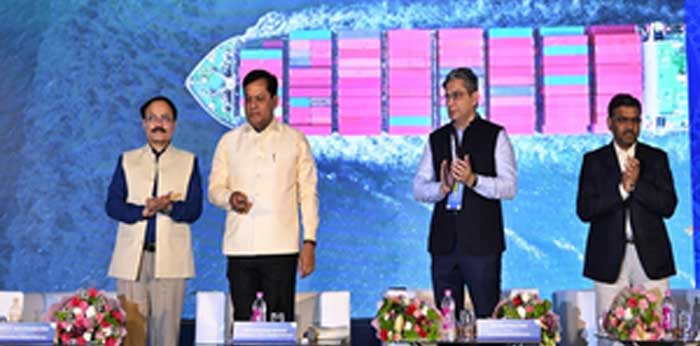- Courses
- GS Full Course 1 Year
- GS Full Course 2 Year
- GS Full Course 3 Year
- GS Full Course Till Selection
- Answer Alpha: Mains 2025 Mentorship
- MEP (Mains Enrichment Programme) Data, Facts
- Essay Target – 150+ Marks
- Online Program
- GS Recorded Course
- NCERT- First Ladder
- Polity
- Geography
- Economy
- Ancient, Medieval and Art & Culture AMAC
- Modern India, Post Independence & World History
- Environment
- Governance
- Science & Technology
- International Relations and Internal Security
- Disaster Management
- Ethics
- Current Affairs
- Indian Society and Social Issue
- CSAT
- 5 LAYERED ARJUNA Mentorship
- Public Administration Optional
- ABOUT US
- OUR TOPPERS
- TEST SERIES
- FREE STUDY MATERIAL
- VIDEOS
- CONTACT US
One Nation, One Port Process
One Nation, One Port Process

Context
On February 27, 2025, Union Minister Sarbananda Sonowal unveiled a series of major maritime initiatives aimed at modernizing India's port infrastructure, streamlining global trade, and promoting sustainability.
Introduction
India’s maritime sector is a cornerstone of economic growth, handling 95% of trade volume and 70% of trade value. With a 7,517 km coastline and 13 major ports handling 60% of total cargo, modernizing port operations is essential. This move aligns with Maritime India Vision 2030 and Sagarmala—initiatives aimed at boosting port efficiency, logistics integration, and sustainability.
One Nation, One Port Process
The One Nation, One Port Process introduces a uniform operational framework across all 13 major ports and several minor ports, integrating best practices and technology-driven solutions to reduce inefficiencies.
Key Objectives:
- Standardisation of Processes:
- Uniform documentation across ports to reduce customs clearance delays.
- Digitalisation of bill of entry, vessel clearance, and cargo documentation to cut processing times by nearly 30%.
- Example: The Direct Port Delivery (DPD) system at Jawaharlal Nehru Port (JNPT) reduced container dwell time by 24 hours.
- Efficiency Gains and Cost Reduction:
- The average turnaround time (TAT) for Indian ports is 26-30 hours, compared to 24 hours in China and less than 12 hours in Singapore.
- The initiative aims to reduce TAT to 18 hours through process automation, better cargo handling, and streamlined customs procedures.
- Enhanced Global Competitiveness:
- Aligning with Singapore, Rotterdam, and Shanghai Port Standards to increase port efficiency by 15-20%.
- India currently ranks 44th globally in port performance, lagging behind China (9th) and UAE (14th).
The ONOP initiative, for example, has already reduced container operation documents by 33% and bulk cargo documents by 29%
Sagar Ankalan
The government has also introduced the Logistics Port Performance Index (LPPI), known as ‘Sagar Ankalan’. This index measures port performance through:
Key Features:
- Key Performance Metrics:
- Turnaround Time (TAT), cargo dwell time, berth productivity, and carbon emissions.
- Mundra Port improved TAT by 15% and JNPT by 12% post-digitalisation.
- Global Benchmarking:
- Comparative evaluation against ports like Shanghai, Rotterdam, and Singapore to enhance competitiveness.
- Target: Reduce operational costs by 10% through efficiency-driven reforms.
- Data-Driven Insights:
- AI-enabled cargo tracking for real-time monitoring.
- Automated berthing schedules to reduce waiting times.
Sagar Ankalan ensures data transparency, creating a benchmark-driven port rating system for continuous improvement.
Summary of other Initiatives
|
Initiative |
Objective |
Key Features |
Impact & Benefits |
Strategic Importance |
|
Bharat Ports Global Consortium |
Expand India’s maritime reach and strengthen global supply chains. |
- Unifies IPGL (operations), SDCL (finance), and IPRCL (infrastructure development). |
- Enhances India’s port expansion and connectivity. |
- Supports Make in India and strengthens global trade relations. |
|
MAITRI (Master Application for International Trade & Regulatory Interface) |
Digital integration of global trade using AI & Blockchain. |
- Establishes a ‘Virtual Trade Corridor’ (VTC). |
- Reduces clearance time for shipments. |
- Strengthens India's position in global supply chains. |
|
India Maritime Week (October 27-31, 2025) |
Celebrate India's Maritime Heritage & Future Growth. |
- Includes Global Maritime India Summit (GMIS) and Sagarmanthan (Strategic Oceans Dialogue). |
- Provides platform for international investment in Indian ports. |
- Boosts global collaborations in the maritime sector. |
|
Shipbuilding Sector Revitalization |
Develop domestic shipbuilding and ship-recycling industries. |
- Introduces Ship Breaking Credit Note Scheme. |
- Enhances domestic manufacturing capacity. |
- Strengthens India’s position as a global shipbuilding hub. |
|
₹25,000 Crore Maritime Development Fund |
Provide long-term financing for port and shipping modernization. |
- Offers long-term credit for infrastructure projects. |
- Funds modernization of ports, inland waterways, and logistics hubs. |
- Strengthens India’s logistics network & infrastructure financing. |
|
National Centre of Excellence in Green Port & Shipping (NCoEGPS) |
Promote sustainability & carbon neutrality in shipping. |
- Focuses on clean energy solutions & green fuels. |
- Reduces carbon footprint in maritime operations. |
- Aligns with Maritime Amrit Kaal Vision 2047. |
These initiatives position India as a global maritime powerhouse, reinforcing economic resilience, trade efficiency, and sustainability under the Maritime Amrit Kaal Vision 2047.
Why Port-Led Growth is Crucial
Economic and Trade Benefits
GDP Contribution
- Efficient ports trigger regional development( The transformation of Jawaharlal Nehru Port in Navi Mumbai has spurred growth in logistics and warehousing sectors)
- 1% improvement in port efficiency boosts GDP by 0.5%.
- The maritime sector contributes 5% to India's GDP, expected to grow to 8% by 2030.
Cargo Handling Growth
- Timely operations lower logistics costs
- In FY 2023-24, major ports handled 1,365 million tonnes of cargo, up 8% from 2022.
- Projected to exceed 2,200 million tonnes by 2030 under Maritime India Vision 2030.
Employment and Skill Development
- Modern ports require a skilled workforce in automation, logistics, and AI-driven port management.
- Mundra Port's digital training program has upskilled 5,000+ workers.
Increased Investment in Infrastructure
- ₹1.5 lakh crore allocated under Sagarmala for port infrastructure and green ports by 2030.
- This influx of capital is expected to modernise facilities, expand capacity, and further drive down operational costs.
Environmental Sustainability
- Visakhapatnam Port reduced carbon emissions by 8% through green port initiatives.
- India targets net-zero carbon emissions in ports by 2040.
Current Issues Surrounding Port-Led Growth
Despite promising reforms, several challenges remain:
- Fragmented Operational Practices:
Inconsistent documentation previously increased turnaround times by up to 25%. - Infrastructure Bottlenecks:
While major ports have attracted investments of over ₹25,000 crores in the last five years, many minor ports receive less than ₹5,000 crores. - Technological Integration:
Some ports, such as Mundra, have embraced automation, whereas others still rely on manual processes, leading to errors and delays. - Regulatory Hurdles:
A complex regulatory framework, involving multiple agencies and jurisdictions, often slows down reform implementation. - Social and Environmental Concerns:
Expansion can lead to environmental degradation and social displacement. Balancing development with sustainability remains a critical challenge. - Turnaround Time Delays:
Indian ports have an average turnaround time (TAT) of 26-30 hours, ranking 45th globally, compared to under 12 hours in Singapore. Delays increase shipment costs and reduce efficiency. - Regulatory delays can add an additional 10-15% to operational costs.
Way Forward
To fully harness port-led growth, a multi-pronged strategy is essential:
- Strengthening Institutional Frameworks:
Establish a unified governance model to streamline decision-making. Enhanced coordination among the Ministry of Shipping, state governments, and private stakeholders is key.
- Investing in Modern Infrastructure:
Increased capital infusion is needed, especially for minor ports. Proposals to invest over ₹10,000 crores in upgrading secondary ports could boost cargo throughput by 25%.
- Leveraging Technology:
Digital transformation is critical. Integrating blockchain, AI, and IoT technologies is expected to reduce operational errors by up to 20% and increase transparency.
- Capacity Building and Skill Development:
Comprehensive training programs in partnership with technical institutes can upskill the workforce. Initiatives like those at Mundra Port have improved efficiency by 30% among trained workers.
- Enhancing Environmental Sustainability:
Future developments must prioritize green initiatives. Investments in renewable energy and waste management systems can lower environmental impact by 8-10% annually.
- Robust Monitoring and Evaluation:
Continuous performance tracking through Sagar Ankalan and regular stakeholder consultations will ensure timely identification and resolution of issues.
- Boosting Digital Adoption:
Digitalisation efforts have resulted in a 20% increase in cargo throughput at several ports, showcasing the positive impact of integrating modern technology into traditional port operations.
- Reduce TAT:
To reduce turnaround times, ports should adopt integrated digital systems, streamline inter-agency coordination, and invest in infrastructure upgrades that facilitate quicker cargo handling and vessel turnaround.
An integrated approach combining regulatory reform, infrastructural upgrades, and technological adoption could boost port efficiency by up to 20% in the next three years.
Conclusion
The One Nation, One Port Process and Sagar Ankalan are transformative reforms poised to make Indian ports globally competitive. By prioritizing automation, standardization, and green initiatives, India can reduce logistics costs by 20%, improve global ranking, and achieve maritime trade dominance.
India’s port sector needs aggressive digitalisation, regulatory simplification, and infrastructure upgrades to achieve world-class efficiency and global trade leadership by 2030.
|
Also Read |
|
| Public Administration Optional | |
| UPSC Monthly Magazine | Question Answer Practice For UPSC |




